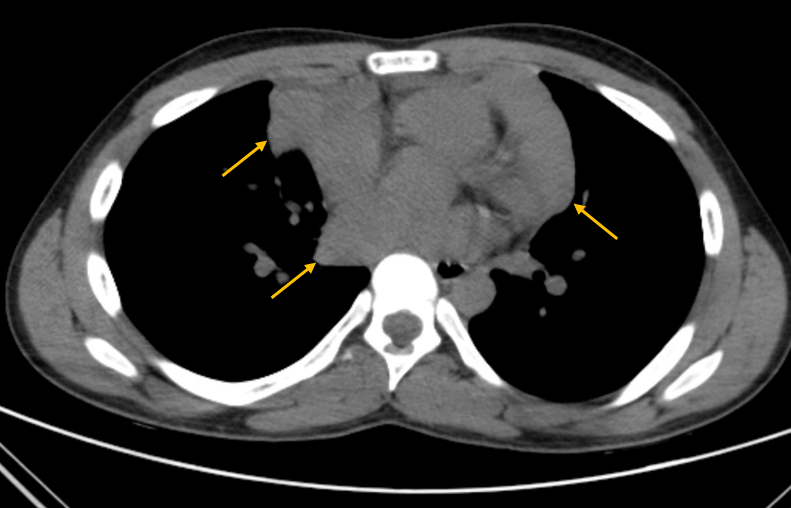Cough and thoracalgia are frequent symptoms in the Pediatric Emergency Department (PED). Although commonly linked to infections or trauma, the pediatrician must stay alert to other possible causes.
A 14-year-old boy, with a previous history of allergic rhinitis, presented to the PED due to sudden onset of a left cervical swelling. He had a six-month history of dry cough and for the last three days he had also been complaining of dyspnoea and thoracalgia (sudden onset during sleep), which was worsening and now radiating to the right shoulder. No other signs or symptoms. On examination, there was a mass on the anterior left cervical triangle, with approximately 2x3 cm, fixed to the muscle below, firm and non-tender. Laboratory studies revealed normal hemogram (hemoglobin 14.8 g/dL, leucocytes 9.3x1^3uL, neutrophils 68.2%, lymphocytes 21.6%) and elevated C-reactive protein (3.28 mg/dL, N<0.5 mg/dL) and lactate dehydrogenase (1113 U/L, N<230 U/L). The chest x-ray showed a large mediastinal mass (Figure 1) in the middle mediastinum, with a 15.13 cm width, prompting an urgent referral to Oncology. CT scan revealed several lymphoid masses, cervical bilateral (the largest on the left, 4x3 cm) (Figure 2) and at the anterior mediastinum (8.5x5.5cm, 7.5x4cm) (Figure 3). Abdominal CT was normal.
The lymph node biopsy, executed at the Oncology Unit, confirmed a diagnosis of T-cell lymphoblastic lymphoma [96% T lymphocytes (CD3+), 0,03% B-lymphocytes (CD19+) and 0,2% NK-cells (CD56+/CD3-)]. He started chemotherapy according to the DFCI-2011 protocol, which includes treatment with vincristine, doxorubicin, PEG-asparaginase, methotrexate, 6-mercaptopurine, dexamethasone and intrathecal triple therapy (prednisolone, methotrexate and cytarabine). After the induction cycle, remission was documented by CT scan. He remained under chemotherapy for two years (a total of 35 chemotherapy cycles). A CT scan performed 1 year after treatment conclusion confirmed a continued complete remission.
Figure 1. Chest x-ray: mediastinal mass (15.1 cm largest width).
 Figure 2.
Figure 2. Cervical CT scan: left cervical lymphoid masses (the largest on the left, 4x3 cm).
 Figure 3.
Figure 3. Thorax CT scan: multiple mediastinal lymphoid masses (8.5x5.5 cm, 7.5x4 cm).

What is the diagnosis?